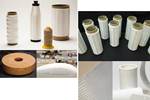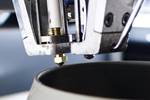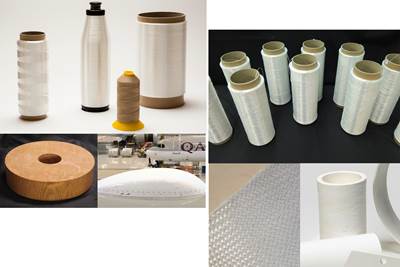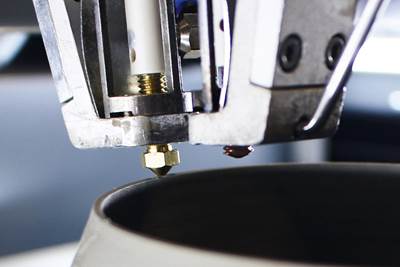Source (All Images) | DLR
(Cologne, Germany) is a spin-off project from the in Cologne, evolving the production of oxide ceramic matrix composite (OCMC) materials and components to enable broader and higher-volume applications. The team, led by DLR scientists Dr. Michael Welter and Dr. Vito Leisner, uses two patented slurry infusion processes developed at DLR since 2017 and proven via small series parts for several pilot projects and DLR flight missions. They are currently working toward commercialization of technology, with planned incorporation of FOX Composites in early 2026.
“Our aim is to use our combined experience of more than 20 years working with CMC materials to move them from research labs and niche markets to broader, large-scale applications,” says Leisner. “Our processes are adapted from the widely used vacuum infusion and resin transfer molding [RTM] processes for carbon fiber-reinforced polymer composites [CFRP] but use instead ceramic fibers and pre-ceramic slurry matrices. We have demonstrated that these processes work and that our OCMC material and parts are reliably high performance. For the first time, we have technology that promises automatable and scalable production of high-quality OCMC parts with near-net-shape geometries in a reproducible way.”
Background and vision
Leisner explains that high-temperature materials are key enablers for many industries, including aviation, air mobility, space, clean energy and defense. “They all face pressure to continuously improve their processes to be more efficient in order to reduce energy use and emissions and also to be more reliable, with less downtime, which means components must last longer, even at higher temperatures.
“However, currently established composite materials are limited with respect to their maximum temperature,” he continues. “CFRP is usually limited to 300°C and highly alloyed steel to 700°C. New materials like CMC easily exceed these limits, but they often lack adequate technology readiness [TRL] to be widely available and applied.”
Leisner notes that current OCMC technology lacks the repeatability and scalability necessary to meet the market demand and potential volume of emerging applications. “Thus, we have thought about automatable, scalable production technologies from the beginning of our technology development,” he explains. “For the next generation of OCMC, we need to go beyond prototyping and small-scale series and demonstrate serial production of OCMC as a necessary requirement to enable broader industrial application.”
Why OCMC versus carbon/carbon or silicon carbide (SiC) CMC? “While all types of CMC offer high-temperature capabilities,” says Leisner, “SiC/SiC CMC are much more expensive than OCMC, primarily due to much higher fiber cost and more complex and slower manufacturing processes. Also, OCMC are inherently oxidation-resistant and don’t need fiber coatings or postprocess anti-oxidation coatings.”
Slurry infusion processes, materials
The two processes FOX Composites is commercializing are vacuum-assisted slurry infusion (VASI) and infusion fabricated oxide CMC (IFOX). “VASI is derived from the vacuum-assisted resin infusion [VARI] process used in CFRP,” explains Welter. “We typically use a one-sided mold in a vacuum bag and then infuse the slurry into a fiber preform using vacuum. For the IFOX process, we use a closed mold system. The positive and negative mold halves define the part shape and wall thickness. Similar to RTM, a fiber preform is placed into the mold system before applying vacuum and pressure for slurry infusion and drying. At the end of the process a dried green body can be ejected from the mold.” These are then sintered in an oven to form OCMC.
FOX Composites team leaders with OCMC materials.
“So far we have developed three different slurry systems for different in-service temperatures and fibers,” says Welter. “We are using the main oxide fibers, including silica, alumina and mullite. At the moment, we mostly use commercially available woven fabrics to develop and qualify our materials. However, our infusion processes allow us to use almost any kind of fiber preform such as felts, short fibers or mixtures, and we see even greater potential for 3D preforms that are tailored to the customer’s design.”
Automation, industrialization of OCMC
First prototype of as-fabricated radar transparent OCMC nose cone made by IFOX process (left). The sub-scale demonstrator rocket (right) features OCMC nose cone, antenna cover and clip-on thermal protection system (TPS) for landing gear.
“We believe our IFOX technology will enable us to go way beyond the volumes that current CMC production technologies can deliver due to high automatability, short processing times and comparatively easy parallelization of processes,” says Welter. “We are currently setting up a pilot production line at DLR to increase the TRL and to demonstrate production capability of 10-20 parts per day. We are also looking at how we can further optimize the process, with the idea to eventually have parallel processing in multiple setups for continuous production, with the goal to produce several thousand parts/year and perhaps eventually up to 10,000 parts/year.”
“At the moment, our process time is around one hour but we believe that we can reduce it even further, to perhaps less than half an hour,” says Leisner. “And this is size independent. So, you can even imagine using a large mold to produce 20 parts in one shot. However, this will obviously require significant investment.”
“The robustness and reproducibility of the process is also very important,” says Welter. “The end parts have high value, even more than CFRP, because the fibers are so expensive and you add so much energy through the sintering. You really need to ensure that you eliminate or minimize fluctuations in quality and also the scrap that you produce. This is also something that we believe is possible with our process.”
What about the ability of prepreg to speed OCMC production? “Using prepreg can help but also has many challenges in production of CMC parts,” says Leisner. “You cannot tune the matrix as much as you want, you’re limited to woven fabrics and you also need to store it. So, it’s a feasible option for some applications, but we believe our approach enables more versatility and scalability.”
Initial parts, roadmap for commercialization
Radar-transparent high-temperature antenna covers for hypersonic flight experiments scheduled for 2026.
Most of the current product development focuses on the defense and space industry, says Leisner, but applications in the chemical industry also look promising. The parts shown at right are radar-transparent antenna covers for a flight mission. “We produced a small series of 10 parts, and this is actually how they look straight out of the mold,” he notes. “We used fabric for these parts, and you need to trim the edges, but with a tailored 3D preform, even that may not be necessary.
“We have also worked on nose cones for rockets and missiles using the IFOX process,” he continues. “We are able to achieve a very high surface quality with very low tolerances right out of the mold. Again, we’re currently working with fabrics, but we are exploring more tailored fiber preforms and working with partners to evaluate these.”
Clip-on TPS for a reusable rocket’s landing gear produced for the CALLISTO project (top) and design study of an OCMC stator guide vane (bottom).
The large piece shown here surrounded by the DLR and FOX Composites team, is a thermal protection system (TPS) for a reusable rocket’s landing gear. “We’re building this for the , a collaboration between DLR, in France and in Japan,” explains Welter. “The goal of the project is to build and test a reusable launch rocket. For the initial hopper tests, we are building the TPS for the landing gear which comprise four OCMC segments, about 1.80 meters in height and 90 centimeters wide. These segments interlock and attach to the landing gear. We have completed a first prototype for the qualification tests scheduled for later this year at DLR. This is another good example of what our technologies are capable of.”
The last sample part discussed is a stator guide vane developed for wind tunnel tests. “This was just to further develop our fabrication capabilities and demonstrate the complex shapes we can make,” notes Welter. “It’s not realistic to put into production because the target application temperature of >1500°C in a first stage high-pressure turbine of a modern jet engine would exceed the limits for OCMC.” He adds that an equivalent SiC/SiC part is being developed by the at the DLR Institute of Structures and Design in Stuttgart. He also notes there are other parts that FOX Composites has produced but which can’t be shown or discussed.
All of these parts are helping the prospective startup to mature its technology and refine its pilot production line. “In the beginning of 2024, we obtained a DLR technology grant to further advance the TRL for serial production,” says Leisner. “We also developed our first prototype products with customers through DLR. At the end of this year, we will begin transferring all of this activity out of DLR to Fox Composites and from 2026, we want to be ready for our first business and grow from there.”
“Our ambition is to provide the first serial production of high-performance OCMC parts in the market,” adds Welter. “We don't see any other technology that is as fast, reliable, scalable and versatile as ours. So, this is the gap that we want to fill.”
Related Content
CIRA qualifies CMC structures for the reusable Space Rider
Italian team designs, builds and tests multiple large, complex thermal protection system structures made from patented ISiComp C/C-SiC ceramic matrix composites.
Read MoreCall for abstracts: CW Tech Days to explore high-temperature composite solutions
The fall 2025 installment of CW’s Tech Days online event series will cover high-temperature composite solutions for defense and space applications.
Read MoreNew GTL breakthrough in composite tubing for liquid hydrogen in aircraft and space vehicles
Tests versus stainless steel tubing show 10 times faster chill down, fuel flow in 2 seconds and less boil-off for significantly faster fueling and refueling of LH2-powered space vehicles, aircraft and trucks.
Read MoreNASA launches composite solar sail into space
Sunlight-based propulsion system, supported by carbon fiber-reinforced booms, will undergo weeks-long testing to demonstrate and verify its capabilities.
Read MoreRead Next
A different Ox-Ox prepreg for faster, more affordable CMC options
Isovolta has developed silica fiber/alumina CERAPREG to enable ceramic matrix composite parts with long-duration service at 900°C and handling similar to epoxy prepreg, dielectric performance similar to quartz.
Read MoreThe future of quartz and oxide fibers at Saint-Gobain Advanced Ceramic Composites
New business builds on 100-year legacy in quartz, prepares for growth, while starting production of oxide fibers to meet increased demand for CMC by aerospace and industrial sectors.
Read MoreA new era for ceramic matrix composites
CMC is expanding, with new fiber production in Europe, faster processes and higher temperature materials enabling applications for industry, hypersonics and New Space.
Read More













